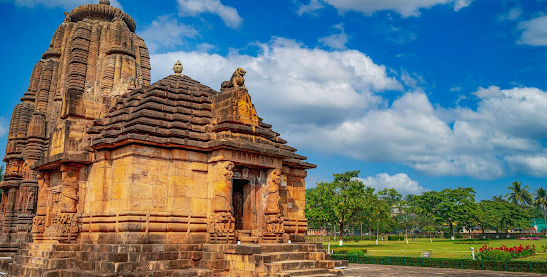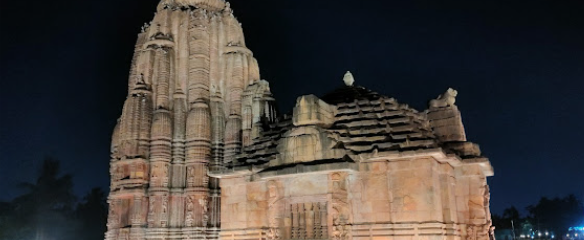The Rajarani Temple is one of the most iconic and historically significant temples in Bhubaneswar, Odisha. Known for its exquisite architecture, intricate carvings, and serene ambiance, the Rajarani Temple stands as a testament to the grandeur of Kalinga architecture, which flourished during the 11th century. While it may not be as well-known as some of the other temples in the city, such as the Lingaraj Temple, the Rajarani Temple offers a peaceful and captivating experience for visitors interested in history, art, and culture.
History and Significance
The Rajarani Temple is believed to have been constructed around the 11th century CE during the Somavamshi period, a time when Kalinga (modern-day Odisha) was at its architectural zenith. Unlike many other temples dedicated to a specific deity, the Rajarani Temple is dedicated to no particular god. This has intrigued scholars and historians, and it is speculated that the temple may have originally been a Vaishnavite temple or perhaps a Shaiva one, with the deity lost to time.
The name “Rajarani” is derived from the type of sandstone used in its construction – a beautiful reddish-brown stone locally known as “Rajarani”. This stone, with its golden hue, gives the temple a unique look, especially when the sun reflects off its surface.
The temple’s striking architecture is characterized by its intricate sculptures, soaring spires, and carefully carved figures of deities, animals, and mythological creatures. Unlike many temples in the region, the Rajarani Temple does not have an idol in its sanctum, but the structure itself serves as an architectural marvel.

Location and Accessibility
The Rajarani Temple is located in the heart of Bhubaneswar, Odisha’s capital, making it easily accessible from various parts of the city.
- Nearest Bus Stand:
- Bhubaneswar Bus Stand (Baramunda): The Rajarani Temple is about 7–8 km from the Baramunda Bus Stand in Bhubaneswar. It takes approximately 15–20 minutes by taxi or auto-rickshaw.
- Unit-I Bus Stand: The temple is located within 3–4 km from Unit-I Bus Stand, the central hub of public transport in Bhubaneswar.
- Nearest Airport:
- Biju Patnaik International Airport, Bhubaneswar: The Biju Patnaik International Airport, located about 7 km from the temple, is the closest airport. It takes around 15–20 minutes by road to reach the Rajarani Temple.
Distance from Major Locations:
- From Bhubaneswar (Baramunda Bus Stand): About 7–8 km, taking 15–20 minutes by car or auto-rickshaw.
- From Biju Patnaik International Airport: About 7 km, approximately 15–20 minutes by taxi or auto.
- From Puri: Around 60 km, taking 1.5–2 hours by car or bus.
Nearby Attractions:
Bhubaneswar, known as the “Temple City of India,” is home to several other historic temples and cultural landmarks. Some of the notable nearby attractions to the Rajarani Temple include:
- Lingaraj Temple – About 3 km from the Rajarani Temple, the Lingaraj Temple is the largest and most famous temple in Bhubaneswar. Dedicated to Lord Shiva, this temple is a must-visit for anyone interested in Odisha’s temple architecture.
- Mukteswara Temple – Around 2 km from Rajarani Temple, the Mukteswara Temple is known for its delicate carvings and intricate design, representing the Kalinga style of temple architecture. It is also dedicated to Lord Shiva.
- Brahmeswar Temple – Located approximately 2 km from the Rajarani Temple, Brahmeswar Temple is one of the oldest temples in Bhubaneswar, dedicated to Lord Shiva.
- Udayagiri and Khandagiri Caves – Situated about 6 km from the Rajarani Temple, the Udayagiri and Khandagiri caves are ancient rock-cut caves that were once home to Jain monks. These caves offer fascinating insights into ancient religious practices and rock art.
- Nandankanan Zoological Park – Located around 15 km from the temple, Nandankanan Zoo is a major attraction in Bhubaneswar, known for its rich wildlife, including white tigers, and its beautiful botanical gardens.
- Dhauli Peace Pagoda – Around 8 km from the temple, the Dhauli Peace Pagoda is an important Buddhist site, marked by the Dhauli Ashoka Rock Edict and a stunning white pagoda that overlooks the Daya River.

Things to Do and Travel Suggestions:
- Explore the Temple’s Architecture: The primary attraction of the Rajarani Temple is its sculptural beauty and architectural style. Take your time to examine the ornate carvings on the walls, which depict scenes from Hindu mythology, gods, and goddesses. The architecture reflects the finest examples of the Kalinga style, and the absence of a central deity makes it an ideal place for those interested in architectural photography and ancient art.
- Photography: The Rajarani Temple, with its majestic spires and detailed carvings, is a photographer’s paradise. Capture the beautiful stonework and intricate reliefs that adorn the temple. The temple is especially captivating in the early morning or late afternoon light when the sunlight enhances the golden hue of the sandstone.
- Visit Nearby Temples: Bhubaneswar is home to numerous temples that showcase Odisha’s unique temple architecture. Combine your visit to the Rajarani Temple with visits to nearby temples like Lingaraj, Mukteswara, and Brahmeswar Temples, which are all within a few kilometers of each other.
- Relax in the Garden: The Rajarani Temple is surrounded by a tranquil garden, making it an excellent spot to relax and enjoy the peaceful environment. Visitors can spend time exploring the garden, which is adorned with manicured lawns and flowers, perfect for a calm retreat.
- Attend the Rajarani Music Festival: The Rajarani Temple is the venue for the annual Rajarani Music Festival, a prestigious cultural event that celebrates classical music and dance performances. The festival, usually held in January, is a great opportunity to experience traditional Indian music and dance in a historical setting.
Travel Tips:
- Best Time to Visit: The best time to visit the Rajarani Temple is during the winter months (October to March) when the weather is cooler and more comfortable for sightseeing. The Rajarani Music Festival, held in January, is also an ideal time for cultural enthusiasts to experience classical music and dance performances.
- Dress Code: There is no strict dress code, but visitors should dress modestly and respectfully, as the temple is a sacred site. Comfortable footwear is also recommended as the temple complex may involve some walking.
- Stay Options: There are several accommodation options in Bhubaneswar, ranging from budget hotels to luxury resorts. Many hotels are located near the city center, making it easy to access the Rajarani Temple and other nearby attractions.
- Local Cuisine: While in Bhubaneswar, try local delicacies such as Dalma, Pakhala Bhata, and Chhena Poda (a traditional dessert made from paneer). Local eateries around the city offer authentic Odia cuisine.
Conclusion
The Rajarani Temple in Bhubaneswar is a hidden gem that offers a unique blend of history, architecture, and tranquility. Its stunning Kalinga-style architecture, intricate carvings, and peaceful surroundings make it an excellent stop for history enthusiasts, art lovers, and spiritual seekers alike. Whether you’re exploring Bhubaneswar’s temple heritage or simply looking for a serene and beautiful place to reflect, the Rajarani Temple provides a memorable experience for all.